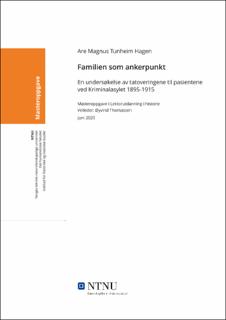| dc.contributor.advisor | Thomassen, Øyvind | |
| dc.contributor.author | Hagen, Are Magnus Tunheim | |
| dc.date.accessioned | 2021-09-13T16:05:10Z | |
| dc.date.available | 2021-09-13T16:05:10Z | |
| dc.date.issued | 2020 | |
| dc.identifier | no.ntnu:inspera:59158535:20662341 | |
| dc.identifier.uri | https://hdl.handle.net/11250/2775594 | |
| dc.description.abstract | Denne oppgaven er en undersøkelse av tatoveringene til pasientene som var innlagt ved Kriminalasylet i perioden 1895-1915. Fra midten av 1800-tallet ble ulike degenerasjonsteorier benyttet som forklaringer på hvorfor noen mennesker hadde psykiske sykdommer, og hvorfor andelen «sinnslidende», angivelig, så ut til å øke. Disse teoriene ble etter hvert tilpasset, slik at de kunne brukes til å forstå kriminalitet og dens opprinnelse. Cesare Lombroso lanserte sin teori om «den fødte forbryter». Han mente enkelte kriminelle var evolusjonære tilbakeskritt. Ved å se på fysiske og psykiske trekk, kunne kriminologer sammenligne kriminelle med «villmenn» og «fargede mennesker», og på den måten bevise hvilke kriminelle som var evolusjonære tilbakeskritt. Lombroso mente tatoveringer var et slikt bevis. Mot slutten av 1800-tallet ble tatoveringer derfor et forskningsobjekt blant kriminologer.
Denne oppgaven har sammenlignet funnene fra forskningen med pasienter fra Kriminalasylet i Trondheim. Målet med oppgaven har vært å finne ut hvilke tatoveringsmotiv som var vanlige, samt å undersøke om tatoveringene viste til en sosial tilhørighet. For å gjøre dette kategoriserte jeg tatoveringene i fem kategorier: skrift, havet, religion, mennesker og symboler. Jeg har også undersøkt om den kontinentale forskningsinteressen som eksisterte ved århundreskiftet 1800-1900, også eksisterte ved Kriminalasylet. Oppgavens problemstilling er: Hvordan skal vi forstå pasientene ved Kriminalasylet sin bruk av tatoveringer i perioden 1895-1915? For å besvare problemstillingen ble det stilt tre underproblemstillinger: (1) Hvilke tatoveringer hadde kriminelle sinnssyke? (2) Viste tatoveringene til en sosial tilhørighet? (3) Var det en forskningsinteresse for tatoveringer blant legene ved Kriminalasylet i Trondheim i perioden 1895 til 1915?
Funnene viser at initialer, ankre, prikker på hendene og ringtatoveringer, var de mest brukte motivene. De fleste tatoveringene kunne plasseres i kategorien skrift og symbol. En gjennomgang av tatoveringene viser at mange var knyttet til en familiær eller en kjærlig relasjon. Ankermotivene kan vise til en yrkestilhørighet, men flere av ankrene var også plassert sammen med initialer av familie og kjære, og kan derfor leses som at det var disse som ga pasientene håp. Tatoveringene av prikker kan vise til en tilhørighet som kriminell eller som «omstreifer». Funnene viser også at bestyrerne ved Kriminalasylet ikke hadde en medisinsk interesse for tatoveringer, men at de ble nevnt som en del av pasientens signalement. Likevel var de tatoverte pasientene assosiert med flere alvorlige diagnoser enn de andre pasientene som ikke var tatovert. Det kan tyde på at pasienter med tatoveringer ubevisst ble diskriminert. | |
| dc.description.abstract | This master thesis is an examination of the tattoos of the patients who were admitted to the Criminal asylum (Kriminalasylet) in Trondheim during the period 1895-1915. From the mid-1800s, different “degenerations theories” were used as explanation as to why some people had mental disorders, and as to why the number of mentally ill seemed to be rising. These theories were eventually adapted and embraced by the criminologists during the last decades of the 19th century. Cesare Lombroso introduced his theory of “the born criminal”. He believed some criminals were evolutionary setbacks. By looking at physical and mental traits, the criminologists would be able to compare criminals to “savages” and “colored people”, and thereby proving the notion that some criminals were indeed evolutionary setbacks. One of these traits were tattoos, which became an object of study.
This thesis has compared the findings of this research by studying the tattoos of patients from the criminal asylum in Trondheim. The aim of this thesis has been to study which tattoo motifs were common, and to analyze if the tattoos were used as a sign of any social affiliation. To do this, I categorized the tattoos info five categories: written tattoos, the sea, people, religious tattoos, and symbols. I have also discussed whether the medio-criminal interest of tattoos was existent at the criminal asylum in Trondheim. The research question has been: How should we understand the use of tattoos by patients of the criminal asylum in Trondheim during the period of 1895-1915? To answer this question, I made three sub-questions: (1) What kind of tattoos did the criminal insane patients have? (2) Did the tattoos symbolize a form of social affiliation? (3) Did the physicians at the criminal asylum in Trondheim show any medical interest in tattoos?
The findings show that initials, anchors, dotted and ring tattoos were the most popular ones. Most tattoos could be placed in the categories “written tattoos” and “symbols”. An analysis of the tattoos shows that family and loved ones were important to the patients. The anchor motifs may have been a professional mark, but several of the anchors were placed together with initials of family and loved ones, meaning it was the family and loved ones who gave the patients some form of hope. The dotted tattoos might indicate an affiliation as criminals, but it was also a symbol used by the Romani-people. The findings also show that the physicians in Trondheim criminal asylum had no medical interest in tattoos, and they were only mentioned as a part of a patient’s physical description. Nevertheless, tattooed patients were often associated with more severe diagnoses than patients who were not tattooed. This may indicate that patients with tattoos were unconsciously discriminated against. | |
| dc.language | | |
| dc.publisher | NTNU | |
| dc.title | Familien som ankerpunkt
En undersøkelse av tatoveringene til pasientene ved Kriminalasylet 1895-1915 | |
| dc.type | Master thesis | |
